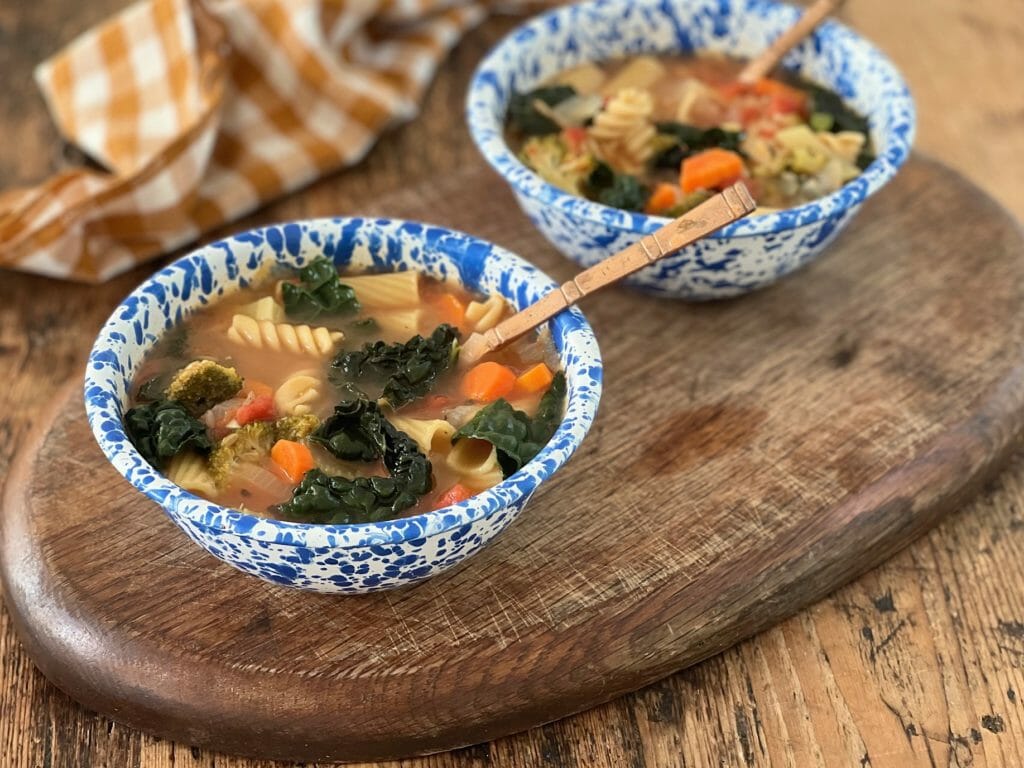Sometimes doing the right thing can feel overwhelming. You hear so much about our warming world that it’s enough to make you want to throw in the towel. That, however, is exactly what I love about this resolution to be better about food waste. It hardly takes any brain power and the solution lies squarely in our own hands. It’s not solar power. It’s not better public transportation. It’s something we have immediate control over. Plus, since the average household throws away between $360 to $2000 a year in in wasted food, there is an economic incentive to boot. This Zero Waste Minestrone Soup is one simple (and tasty) way to get started.
Turn Food Waste into Soup
Consider this soup a food waste prevention recipe. It’s hard to think of a better way to use up what you have in your fridge and pantry than a pot of soup. It’s all about using whatever leftovers you have on hand, so think of it more as an outline. Soup makes good sense now, since it’s winter, but there are so many other ways to use up leftovers.
More Zero Waste Ways with Leftovers
- Sauces: Add extra veggies to sauces, even if the recipe doesn’t call for it. I’ve rarely seen a few extra collard leaves ruin a dish.
- Stir-frys: This is probably our household’s most common use of extra veggies. Make a “fried rice” with any extra meat or veggies we haven’t managed to use up in other recipes.
- Salads: If you’re shooting for a healthy meal anyways by eating a salad, why not poke around your fridge and pantry to see what you can use up. Fruits, greens, vegetables, beans, legumes, meat, poultry, cheese, and eggs are all fair game.
- Sandwiches: Leftover turkey, chicken, or firm fish like tuna or salmon can turn into an easy meal with a bit of mayo, diced celery/fennel/apples and voila! Lunch or a light supper is served.
- Blended soups: The beauty of these kinds of soups is that you can usually toss almost any kind of vegetable in there and it works. Plus, it’s a great way to get a few more veggies into your kids.
- Broth: Store chicken or meat bones, as well as vegetables scraps (think kale stems, corn cobs, carrot tops) in the freezer until you are ready to make a batch of broth. Easy.
Also, if you are looking for more inspiration, head on over to Love Food, Hate Waste, a site devoted exclusively and passionately to the subject of food waste.
Zero Waste Minestrone Soup
Ingredients
- 1 tablespoons extra-virgin olive oil
- 1 large onion, diced
- 2 cloves garlic, finely chopped
- 2 to 3 cups raw vegetables, cut into bite-size pieces
- 6 to 8 cups chicken, vegetable, or beef broth
- One 15-ounce can diced tomatoes
- 2 bay leaves (or a few sprigs of fresh herbs, such as thyme, basil, tarragon, or oregano)
- Salt
- Fresh cracked pepper
- Parmesan rind, if you have one
- 4 to 5 ounces uncooked pasta, such as penne, farfalle, or rotini (see note)
- Large handful leafy greens, such as raw spinach, kale, chard, or collards, stemmed and chopped (optional)
- 1 to 2 cups leftover chopped poultry, meat, or cooked beans or chickpeas (optional)
- Parmesan cheese for serving
Instructions
-
Heat the olive oil over medium in large pot. Add the onion and saute until tender and translucent, about 5 minutes. Add the garlic and sauté until fragrant, another minute or 2.
-
Add 6 cups of chicken broth, tomatoes, and any longer-cooking vegetables (ie potatoes, carrots, winter squash, parsnips, broccoli, bay leaf, a generous pinch of salt, black pepper, and the Parmesan rind (if using). Turn up the heat and bring to a boil. Reduce heat until the broth simmers and cook 10 minutes until the vegetables are nearly tender.
-
Add the beans, any quicker cooking vegetables (ie zucchini, bell peppers, or asparagus), and the uncooked pasta. Continue to cook at a high simmer until the pasta is al dente. Add more broth, as needed.
-
Add the greens and cooked meat/poultry/beans (if using) and cook just until heated through. Taste and add salt and black pepper to taste. The amount of salt will vary depending on the type of broth you use. Remove the Parmesan rind and bay leaves before serving.
-
Serve with freshly grated Parmesan cheese over the top.
Recipe Notes
If you have leftover cooked pasta, feel free to use that in place of the uncooked pasta and add it at the very end of cooking the soup. Figure you'll need about 2 cups of cooked pasta. You can also use leftover rice, barley, or other grains in place of pasta if you happen to have that on hand.
